Final report for FS18-310
Project Information
Mulching of vegetable crops in the South provides an effective way to maintain soil and plant health by reducing soil-borne pathogens, weed pressure, and soil moisture loss while increasing organic matter over time. However, the cost of mulching decreases early season cash outlay, potentially lowering seasonal and overall farm profits due to the increase cost in materials and labor if yields aren't increased. Farmers in the Southeastern U.S. need a way to offset the cost of mulching through either an increase in overall farm sales or a decrease in cost of straw and labor.
By incorporating mushrooms like Stropharia rugosoannulata and Hypsigus ulminarus into the mulch, farmers have the potential to further increase soil fertility and plant health while increasing revenue across the Southeast as both of these species can be grown in temperate and subtropic climates.
Mushroom mulches would also rapidly build soil because the enzymes the mushrooms exude for digestion would increase the decomposition rate of debris into organic matter, micro, and macro nutrients. This research project will provide tangible, Southeastern specific results as to whether and by how much mushroom mulch intercropping increases vegetable yields while bringing in new, diversified income to small farmers. This research is critical in providing data for Southeastern U.S. growing conditions, to determine potential vegetable yield increases, sustainability benefits, and potential additional revenue from mushroom crop. While the benefits of mulch are known, mushroom crops may be a way to reduce financial risk of mulch by increasing diversified revenue streams. Intercropping mushrooms with vegetables has some anecdotal evidence of providing these benefits.
We will measure relative costs of set-up and maintenance of various mushroom mulches, comparative yields between mulched and non-mulched vegetable cash crops, and soil moisture and weed pressure in the various treatments.
Research
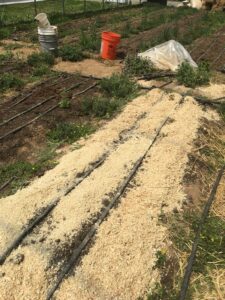
Henosis Planting and Innoculation Succession
We decided that the best action to ensure that mycelium (fungus) would run along the mulch and have a chance of fruiting was to plant broad leaf vegetables first, spread straw mulch and sawdust (a common substrate material in oysters production) and then inoculate the beds with Wine Cap in the path ways and elm oyster (Hypsizygus ulmarius ) in the vegetable beds.
Following the steps in Paul Stamet's book "Mycelium Running", we layered water saturated poplar sawdust, mushroom spawn (80% sawdust and 20% coffee silver back) and a layer of straw mulch on top (approximately 18 bales) 1.5 bales/30 ft row. We watered the sawdust in a watering trough and spread it around the vegetables. We then added two 5 pound bags of sawdust spawn on top of the saw dust layer, added more water, and a layer of wet straw mulch.

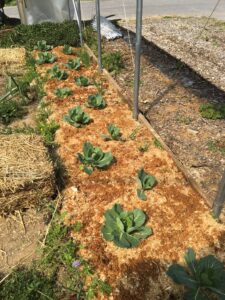

We used the same process for the six control beds minus the mushroom spawn. All the beds were approximately 4 - 6 inches deep with mulch and sub-layers.
We then watered each bed by hand every day for two weeks approximately 10 minutes/bed to ensure that the fungus would establish itself and not dry out. Afterwards, we relied on drip tape on the top of the mulch to maintain adequate moisture level. We also added an additional bed outside the hoop house to increase our level of control over the fungal analysis. The same method was applied; sawdust, spawn, and straw but it was open to the elements.
After the initial mushroom beds were created with poor results in fungal growth and mushrooms production, we confided in the expertise of Field and Forest whom suggested we mulch thicker to 10" in depth so to keep moisture levels adequate in the full sun after having soaked the straw for 24 hours.
Executive Summary
We learned from our study that many of the methods practiced in books such as "Mycelium Running", need to be replicated and refined under multiple environments. Discussing your plan and execution method with a multitude of experienced mushroom industry folks is recommended before trying inovative mushroom cultivation techniques to minimize losses and time wasted. Elm oyster mushrooms did not prove strong enough to establish itself in the straw/sawdust mulch no matter the saturation rate. Further explanation from the original researcher in "Mycelium Running" of proper methods and or strains used is needed. Not only was our experiment a failure with the strain but having discussed it with Field and Forest they said it was a poor producer for them as well.
Furthermore, Field and Forest did not believe that Wine Cap mushrooms would be suited for greenhouse vegetable production and our study proved that to be true. We did not produce any mushrooms as the temperature in the South is too high to allow for adequate mycelium growth. Aside from poor growth, the method for applying mulch in these systems for leafy green crops like beets is too cumbersom and labor intensive to be profitable at least by hand. A tractor seeder may be used to penetrate a mulch layer but further studies would need to be executed. Larger fruiting crops such as tomatoes and squash, while easy to mulch did not provide adequate shade to reduce temps in this system to maintain fungal growth as once speculated. Neither plot showed significant difference in vegetable production to conclude that one was more fertile than the other.
The soil health did improve over time but would have to be attributed to just using mulch not inoculated mulch as neither Plot A or B ever showed substantial fungal growth from our site analysis.
From Plot A and Plot B (the control) we didn't see any evidence of an increase in production and or revenue from mushroom production. Weighing the vegetables and visually inspecting the beds for mycelial growth did not lead to the conclusion of higher production of vegetables or a potential added revenue stream of wine cap or elm oyster mushrooms as the substrate and watering mechanism was ill suited for adequate mycelial (fungal) growth. Just using elm oyster spawn, we did not see any adequate fungal growth in the bed exposed to the elements either.
The following chart is a side by side of vegetable yields between Plot A (Inoculated plot) and Plot B (Control):
|
||||||||||||||||||||||||||||||||||||||||||||||||||
|
||||||||||||||||||||||||||||||||||||||||||||||||||
|
||||||||||||||||||||||||||||||||||||||||||||||||||
Fall 18"
We did not see a significant turn out in any crop production due to poor germination from excessive heat and poor watering practices trying to increase fungal growth thru overhead watering techniques. This watering technique proved to be ill effective in producing mushrooms or vegetables. The cabbage rotted and the beets and kale never reached full maturity.
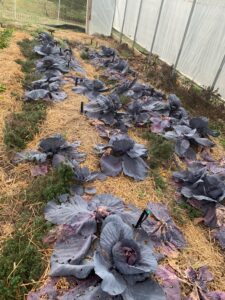

Spring 2019
The production difference between Plot A and Plot B for beets was insignificant. For cabbage, Plot B out performed Plot A by 413 ounces or was 18% more productive by weight. Kale did not see a significant difference in production
Summer 2019
Plot B outperformed Plot A in proudction of both Sweet Potatoes and Squash. With 30% more production in sweet potatoes and 320% in squash. Plot A only outperformed Plot B in tomato production by 103%.
Fall 2019
We suffered a severe crop loss due to adverse weather from excess heat. No crops were produced.
Changing mushroom inoculation methods still did not increase mycelium growth or produce any mushrooms. Due to the lack of mycelium growth the it can not be said that the vegetable production of either plot was because of that differential.
Soil Health
Plot A: The initial soil test did not provide a great baseline to work with as the soil was very fertile receiving an over all grade of 84 or "Optimal" by Cornell's Soil Health Standards. However, there was improvement from the spring to fall season. The biggest improvement was in aggregate stability with a value raise from 38.8 to 69.6, ACE soil Protein Index, Soil Respiration and extractable Potassium and extractable phosphorus*
There were decreases in organic matter from 6 - 4.9 and active carbon from 980 to 927.
Comparing the initial test of Plot A and B there were only slight differences in overall health. The main differences were in organic stability, ACE Protein Index, Extractable Phosophorus, and Extractable Potassium
Plot B: There were improvements to Plot B's overall soil health with the highest increase in aggregate stability from 45.5 to 74.2. There were decreases in Active Carbon (1009 - 927) and Extractable Potassium 394 - 232.
Comparing the soil activity over time between Plot A and Plot B we did see slightly better increase in overall soil health from A over B. The biggest changes coming in the form of ACE Soil Protein Index in the positive and a significant decrease in potassium of Plot B over Plot A which showed an increase of 3.7.
| Soil Attribute | Plot A Point Change | Plot B Point Change | Point Difference |
| Aggregate Stability | 30.8 | 28.7 | 2.1 |
|
Organic Matter |
-1.1 | -.4 | .7 |
|
ACE Soil Protein Index |
29 | .3 | 28.7 |
| Soil Respiration | .4 | .1 | .3 |
| Active Carbon | - 53 | - 82 | 29 |
| Soil pH | .1 | 0 | .1 |
| Extractable Phosphorus | 68.1 | 71.7 | 3.6 |
| Extractable Potassium | 3.7 | -161.7 | 158 |
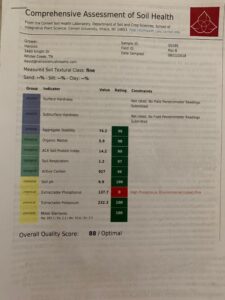
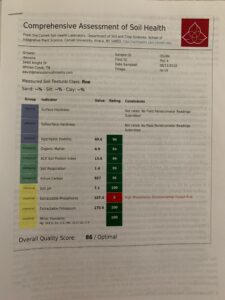
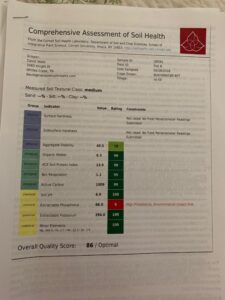
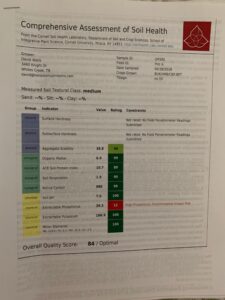
*The build up of extractable phosphorus in open air systems could be seen as a potential environmental hazard if soil runoff should ensue and pollute a body of water.
Further studies need to be conducted as we did not see a significant change in soil health outside of potassium loss and due to the lack of fungal growth we cannot infer that it was due to mycelium.
Labor and Materials
Labor Applying Mulch and Inoculating
Mulching for one row 10 inches thick of water soaked* straw takes approximately 45 minutes. It takes approximately 30 minutes to apply 2 (5.5 pound) bags of spawn on a 30' x 40" bed. Total prep for one bed by hand takes 1.15 hours to mulch and inoculate.
Educational & Outreach Activities
Participation Summary:
Due to the lack of fungal growth and establishing best managment practices (BMP's) for creating mushroom beds outreach was at a minimum until we could adequately establish growing parameters. Farmer's time is limited and we felt that bringing people out to see a lack of positive progress was overly zealous when a simple report would provide adequate understanding of the progress.
We did give several one-on-one personal tours to farmers and told them about the progress and participated in the Middle Tennessee Farmer's meeting to tell them about our work. No materials were made until we could establish better (BMP) and have more success in fungal maturation.
Learning Outcomes
Establishing best management practices for fungal beds is key to the success of growing mushrooms in this type of system. Simply following the loose instructions in Paul Stamet's book "Mycelium Running" did not prove to be an effective way to grow Hypsizygus ulmarius mycelium on sawdust and straw mulch, let alone mushroom fruiting bodies. Having discussed my results with another mushroom company, Field and Forrest, whom had done their own research on using Elm Oyster they too concluded that this type of fungus was not suitable for outdoor production in this manner but suggested that we use another mushroom in the Pleurotus genus as they hypothesized that it would have the vigor to establish itself as it did not yield in our study both in and out of the controlled environment.
We were also given better instructions on how to maintain proper moisture through irrigation. Instead of using drip tape which has a limited percolation surface area, and staked spray nozzles which creates disease on vegetables, it was said that we use soaker hoses. It was also discovered that there are two types of sawdust: wet sawdust which comes straight from a felled tree, and kiln fired sawdust from mills making lumber. In this study we were using sawdust from kiln-fired wood that was extremely hydrophobic even after having been soaked in a trough. This material proved to be immensely hard to keep moist and would not be cost effective to hand water or soak to maintain low overhead cost.
Establishing fungal beds and creating a system of maintenance is key to the success of growing mushrooms in this type of system. Elm oyster mushrooms are not a good choice for this type of system.
Root vegetables (beets) are not easy to sow in this mulch systems due to the burden of moving mulch and not being able to use a seeder.
Watering overhead was not adequate in maintaining moisture levels in the beds and rotted the vegetables. Soaker hoses as mentioned by Field and Forest in their study may prove to be more effective in maintaining proper moisture in the mushroom mulch.
None of the beds saw any clear difference in production output.
Project Outcomes
Farmers now have a better understanding of what can be achieved using different methods of intercropping vegetables with two different varieties of mushrooms under new conditions. By replicating and cross-examining experiments from other more experienced companies, we were able to dispell the belief that using Elm Oyster spawn in vegetables systems is a way to increase production of vegetables. The Elm Oyster mycelium did not run in either the hoophouse system or the vegetable beds exposed to the elements that received adequate rain and shade. Furthermore Wine cap mycelium would not effectively expand in hoop house system having used multiple crops and watering systems. Despite the underwelming results having not cultivated mushrooms, we have data on labor cost of mulching and it's effects on soil health.
More and more people are captivated by fungi and need to be informed of best management practices. Often times replicating what is shown in books proves to be illfitted in producing ideal results from lack of details in said books and environments where the experiments first took place. What may apply in one condition may not apply in another because of poor mushroom genetics, inadequate substrate, or adverse environmental conditions. Furthermore, while Henosis did not see any mushrooms, other studies have proven that they can be grown in this mulching system outside of hoop houses along side vegetables. Aside from this conclusion it must also be pointed out that we did not use sprinkler systems with just mushrooms in mulch beds. This could lessen the overall complexity of growing two types of crops; vegetable and mushrooms and allow for mushroom cultivation to take place on its own as a means to prep beds and alternate mushrooms and vegetable production similar to cash crop and cover crop successions. It must also be pointed out that while wine caps are not adequate for these types of conditions, Field and Forest has mentioned that the Agaricus subrufescens (Almond Portabello) mushroom may be suited for this type of system more as it is a tropical mushroom that can withstand temperatures above 80F and be grown in composting systems.
Further research needs to be conducted with this type of system using different mushrooms such as Agaricus subrufescens on compost. Field and Forest research with wine cap mushrooms needs to be expounded upon using other vegetables in an open-air system to determine plant and soil health.
Also, while intercropping vegetables and mushrooms is very complex in the same system further studies should be conducted in two closed systems. Using the technology of hydroponic and aquaponic systems and the closed systems of mushroom production we could conceivably tie those two systems' air exchanges together to regulate carbon dioxide and oxygen levels benefiting both kingdoms and lessening the need for expensive air scrubbers used in indoor hemp production, as plants breath carbon dioxide and mushrooms breath oxygen.